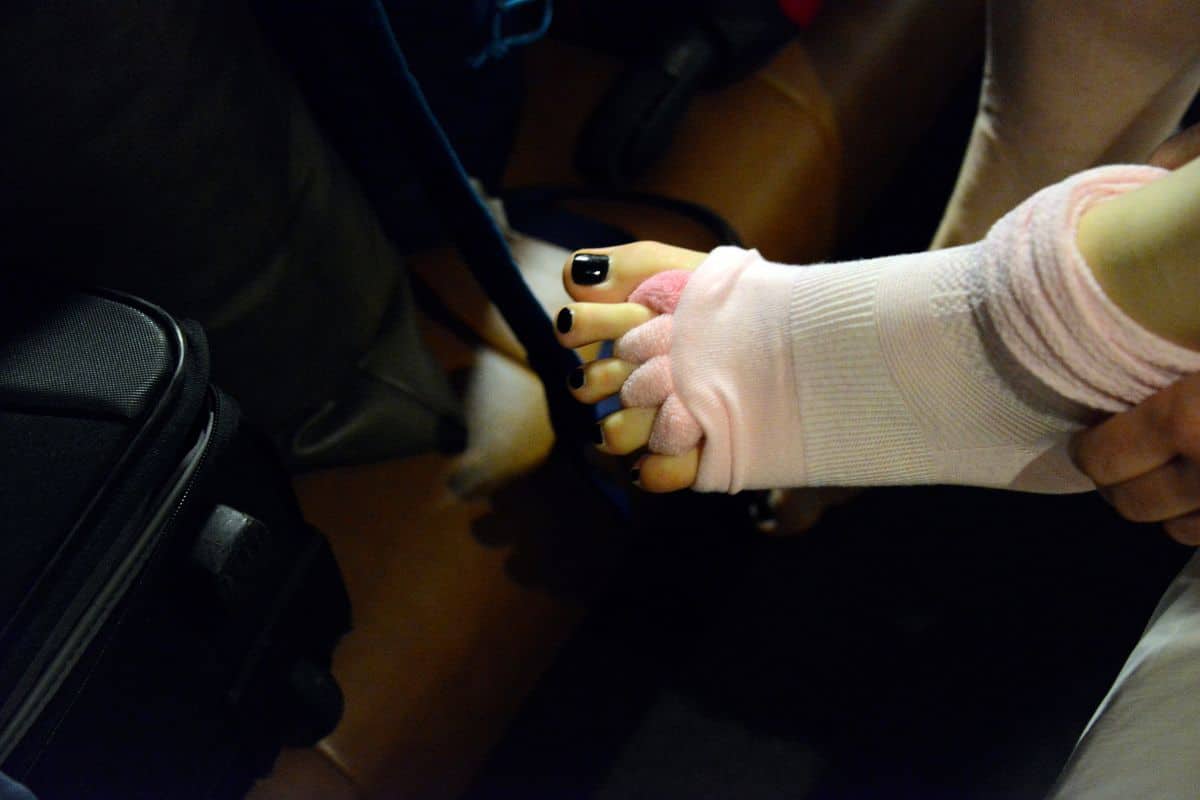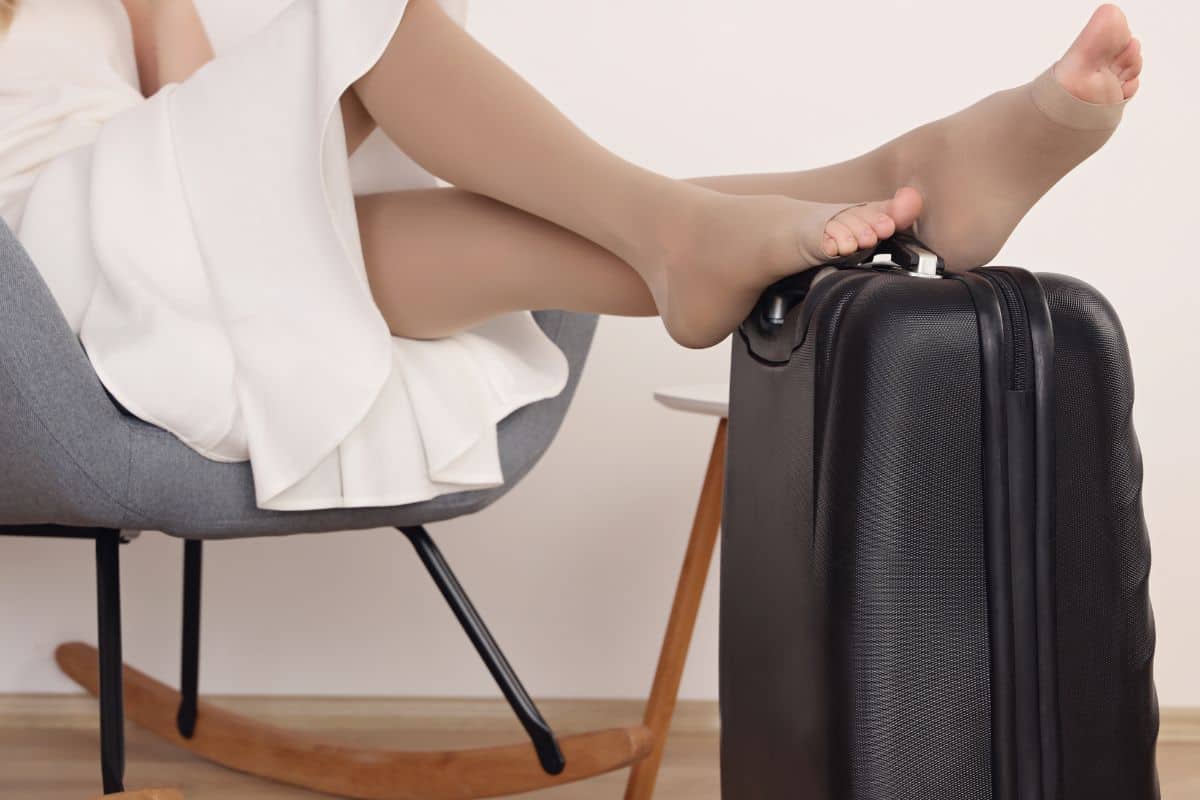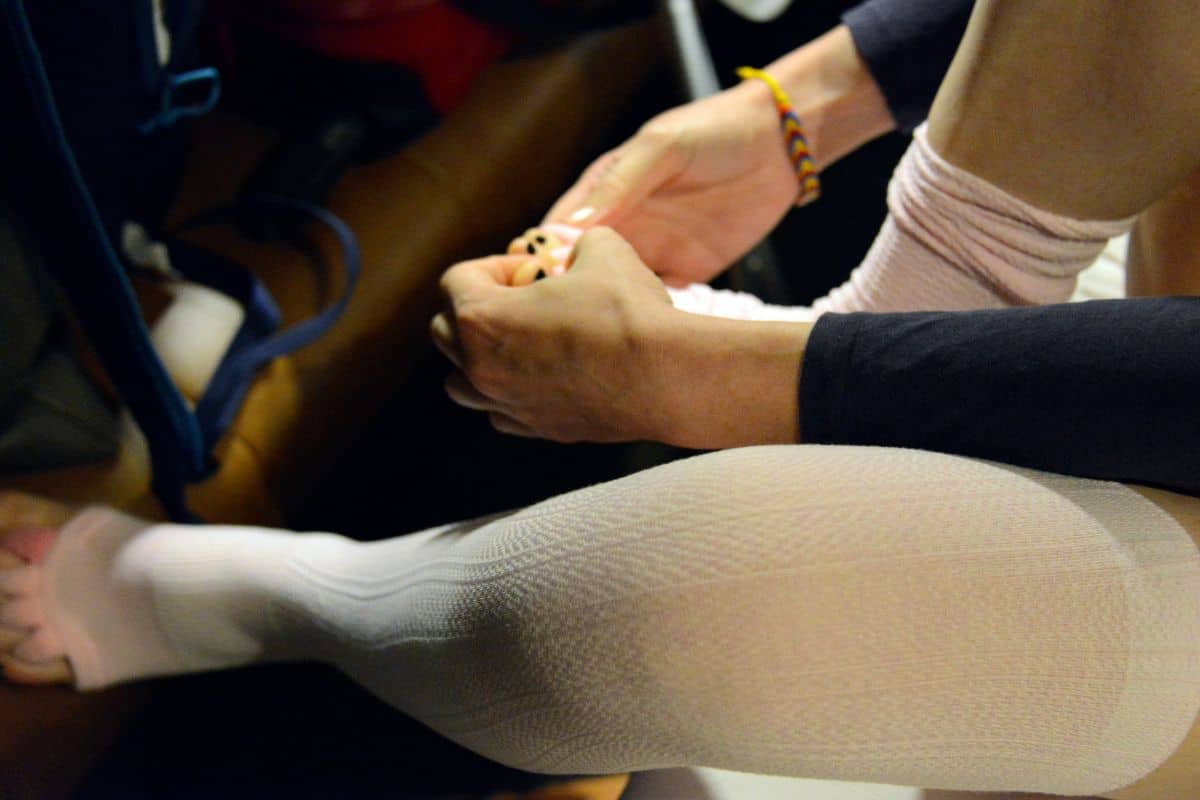Medicare Part B benefits frequently include items classified as durable medical equipment.
Compression stockings would meet part of the eligibility for durable medical equipment status because they may be medically necessary in some cases.
Unfortunately, most compression stockings do not meet the other criteria for being covered under this definition.
Table of contents
What Are Compression Stockings?
In health care, compression stockings are very important and are essential to a lot of people.
Because they apply constant pressure to the leg, they help to keep blood flowing, prevent clots from forming, and reduce the risks associated with poor circulation in the lower limbs.
These stockings may be made of a combination of natural and synthetic fibers, allowing them to stretch and breathe around the skin without causing sores to form or making you sweat.
Stockings can be knee-high or thigh-high, or they can be worn like tights all the way to the waist.
While the majority of compression stockings are available over the counter, your doctor might need to prescribe a customized type based on your measurements.
Stockings that are not fitting properly can aggravate circulation issues rather than help them, so getting the right fit is critical. If the stocking’s tops or bottoms are too long, folding them over can cut off blood flow.

Support Stockings
These compression socks or stockings apply the same amount of pressure throughout the stocking.
You can wear them to improve your comfort if your legs ache at the end of the day. They are available online and in many drugstores.
Antiembolism Stockings
Antiembolism stockings work to prevent blood clots when you can’t get up and walk around, such as after surgery.
Depending on your doctor’s recommendations, these stockings provide varying levels of compression.
Graduated Compression Stockings
Most of the pressure is applied to the ankle with these graduated compression stockings and gradually reduces pressure as they move up your leg.
They usually necessitate a professional fitting to ensure proper pressure and fit. These are typically purchased at a medical supply store.
Compression Stockings Uses
Compression stockings are used for a variety of reasons, the most common of which is to treat circulation issues caused by diabetes or after surgery.
They are also useful for anyone who spends the majority of their time in bed or who is unable to move their legs much.
Because of the impact these conditions have on circulation and the risk of blood clots traveling to the heart and lungs, as well as this, compression stockings are typically used to help those with varicose veins or deep vein thrombosis.
Anyone who works on their feet for long periods of time can benefit from the improved circulation provided by compression stockings. Athletes also use them to aid muscle recovery after strenuous activity.
How Compression Stockings Work?
The pressure these stockings apply to your legs improves the function of your blood vessels.
Blood can flow freely because the arteries that carry oxygen-rich blood to your muscles can relax. The veins receive a boost, allowing blood to return to the heart.
Compression stockings can help prevent tired and achy legs. They can also help prevent and treat spider and varicose veins, as well as reduce swelling in your feet and ankles.
They may even prevent you from feeling dizzy or light-headed when you stand up.
Because the blood is constantly moving, it is more difficult for it to pool in your veins and form a clot.
If one forms and escapes, it can travel with your blood and become lodged somewhere dangerous, such as your lungs.
Clots can prevent blood to flow around them, which can result in swelling, discolored skin, and other complications.
Compression Stockings And Medicare
The vast majority of Medicare beneficiaries receive their benefits through either Original Medicare or Medicare Advantage.
Original Medicare divides its coverage into three parts: A, B, and D.
The Part A of Medicare covers a large portion of the cost of inpatient hospital care, while Part D covers prescription drugs.
When it comes to Part B benefits typically include durable medical supplies and other outpatient benefits. Part B usually does not cover over-the-counter items like bandages, disinfectant, gloves, and compression garments.
There are some exceptions to this rule, but the best way to find out what your benefits are is to speak with a knowledgeable Medicare representative.
You may be able to get assistance paying for compression stockings through Part B if they are directly dispensed to you by your doctor or if you must purchase them from a retailer authorized to bill Medicare.
However, stockings are not covered by Original Medicare.
Some Medicare Advantage plans may provide additional benefits such as an allowance for over-the-counter medical supplies.
Prescription compression stockings may be covered under usual benefits or by a provider’s allowance for over-the-counter items for dual-eligibles who also receive Medicaid assistance.
If you have a Medicare Advantage Part C plan, you may be able to get compression stockings covered.
If Medicare customers are prescribed compression stockings to treat open venous stasis ulcers, Medicare benefits under Part B may be available as this is classed as wound care rather than durable medical equipment.

Compression Stockings Cost
The cost of compression stockings varies according to the amount of pressure applied, the material of the stockings or socks, and the medical purpose.
Some stockings and socks have graduated compression, which means the compression is greatest at the ankle and decreases as it approaches the knee.
Typical compression stockings and socks apply the same amount of pressure throughout and may be labeled as ‘uniform’ compression.
Graduated compression stockings are usually fitted by a doctor or a professional.
Compression stockings are measured in millimeters of mercury (mmHg). 15–20 mmHg and 20–30 mmHg are two common measurements.
Some stockings are also available with ‘extra firm’ compression of 30–40 mmHg. Compression stockings with a pressure range of 40–50 mmHg are typically only available by prescription.
Prescription compression stockings are typically obtained from a medical supply store.
If the compression legwear is considered a wound dressing, the customer should check to see if the store accepts Medicare.
The doctor will frequently recommend local medical supply stores or online pharmacies that can provide the socks and stockings.
Summary
As we have covered, compression stockings can relieve a lot of pain and discomfort, so it is unfortunate that it is not usually covered by Medicare.
However, if your doctor has prescribed them to you for the treatment of wounds then they will very likely be covered by Medicare.
As well as this, if you are experiencing complications related to the cause of your leg pain or from surgery, doctor’s visits, and other therapies may be covered by Medicare.
Having said this, even if Medicare covers some of your costs, you will almost certainly be responsible for out-of-pocket expenses such as co-payments, deductibles, and coinsurance.
Starting January 1, 2024, Medicare will pay for lymphedema compression treatment items for Medicare Part B patients.
You are only eligible for reimbursement if you have a medical diagnosis from your doctor. If this is the case, you will often receive 100% of the purchase price with a basic insurance, provided the stocking is purchased from a supplier who is affiliated with your health insurer.
Compression stockings of 20 mmHg or higher need to be prescribed by a physician. They are used for the treatment of various medical conditions, and should be used under the supervision of a doctor. The prescription for them needs to be renewed on an annual basis.
